As new liquefaction capacity clashes with stagnant LNG consumption, a short-term glut is imminent. The industry could get a boost, though, from Europe’s efforts to limit dependency on Russian gas.
David Wood, David Wood & Associates, Lincoln, UK
Global demand for LNG is growing at its lowest rate in more than a decade due to global economic recession, falling oil and oil product prices, high and volatile natural gas prices relative to competing fuels (which have prompted some consumers to switch to more stably priced fuels) and increased confidence in US gas production and reserves.
The slowdown in LNG demand is happening as the LNG industry is about to increase supply capacity by some 50% over the next three years, with about half of the new capacity located in Qatar. A short-term supply glut seems inevitable. Many of the suppliers of short-term cargoes with destination flexibility-who benefited from the very high unit prices that Asian buyers were prepared to pay between July 2007 and October 2008-will find difficulty in landing such cargoes at premium prices in 2009. The reason that the industry is underpinned by long-term Sale and Purchase Agreements (SPAs) will again become evident.
This change in market conditions is likely to lead to some liquefaction development projects being delayed or cancelled. Along the supply chain, it is expected that some regasification terminals will operate at low load factors or perhaps even be mothballed (e.g., in North America). This is ironic given that only a year or so ago several proposed LNG regasification terminals in North America and Europe were delayed due to increasing costs and their inability to secure LNG supply commitments in what was seen as a market with insufficient future supply. An extended glut is also expected in LNG shipping, due to the large capacity of new LNG carriers that have entered the market in 2008, including several large Q-Flex and Q-Max membrane-type ships developed by Qatar Petroleum and ExxonMobil to service the Qatar supply contracts.
Many analysts and those companies with exposed positions along the LNG supply chains continue to forecast a supply shortfall and seller’s market beyond 2012 due to the slowdown in commitments to new development projects and increased demand, particularly in Asia and Europe. Of more immediate concern is at what level of demand the industry will stabilize in 2010, and that is very price dependent. However, the long-term supply constraints cannot be ignored. With a construction period of some three to five years for a greenfield liquefaction plant from Final Investment Decision (FID), and with only five positive FIDs made during 2006 - 2008, only some 20 - 25 million metric tons per year (MMty) of new LNG supply will enter the market from 2011 to 2013 (or perhaps to 2015).
Market recognition of a potential LNG supply crunch could raise concerns over security of supply, dampen LNG demand growth and boost interest in large-scale gas pipeline projects into all three main gas markets (i.e., Alaska to Lower 48; Russia and Caspian to China; Russia, Caspian, Middle East and North Africa to Europe), the building of more nuclear plants, and renewed investment in “clean coal” research.
LNG prices outside North America remain primarily indexed to crude oil prices. Many believe that LNG price volatility will persist while LNG prices remain exposed to crude oil price fluctuations in both long-term and spot contracts. Sellers demonstrated during 2006 - 2008 their enthusiasm to persist with oil indexation and-through higher oil price ceilings and pricing formulas closer to oil parity-extend rather than reduce the price impact of crude oil on LNG. Price volatility and uncertainty (i.e., fear of very high prices under oil-indexed price formulas) are likely to destroy some LNG demand in the coming years.
MIDDLE EAST
Although LNG liquefaction capacity is spread around the world, the expected commissioning schedule is dominated by Qatar, Fig. 1. In other Middle East developments, Dubai Supply Authority (Dusup)-a government entity that owns the emirate’s gas pipeline network and has the sole rights to supply gas users-announced plans in 2008 to build a floating LNG regasification facility at Jebel Ali port. Under the plans, an existing LNG carrier will be converted into a floating storage and regasification unit with capacity of 3 MMty (or 0.4 Bcfd). Shell has signed an agreement to supply Dubai with 1.5 MMty from 2010, which year may see some LNG imported to the Persian Gulf.
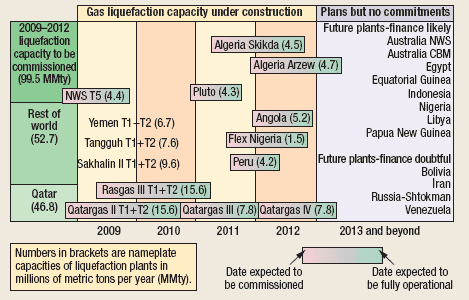 |
|
Fig. 1. Gas liquefaction plants to be commissioned and their capacities.
|
|
Also during 2008, Iran announced its intent to prioritize gas pipeline exports, particularly to Pakistan and Oman. This comes after a decade of discussing various gas liquefaction projects with foreign companies. Hence, LNG exports from Iran before 2015 now seem unlikely.
ASIA
Emerging Asian LNG consumers India and China will undoubtedly play a role in future LNG demand growth, and that will provide the demand to support more substantial supply capacity if prices remain low. Five million metric tons of LNG per year supplied by Qatar’s RasGas to India’s Petronet LNG under Phase 2 of a long-term contract is being delivered as of January 2009, with prices varying monthly linked to the Japan custom-cleared crude rate. For the first five-year phase of that contract (2004 - 2008), India benefited from prices held low by the fixed $20/bbl crude marker in its LNG price formula, which equaled $2.53/MMBtu for LNG on a Free-On-Board (FOB) basis. Supplies under the agreement may increase starting in 2010 depending on negotiated prices. India has been planning to expand its regasification capacity for several years. However, in the longer term, LNG demand and pricing will likely be constrained by the development of India’s recently discovered large east coast gas fields, Dhirubhai and Deen Dayal.
Downstream consumers of LNG imports at the Dapeng terminal in Guangdong, China, such as power plants and industrial users, have substantially reduced their demand for gas due to the economic slowdown. As recently as September 2008, the Dapeng terminal paid more than $20/MMBtu for an Algerian spot LNG cargo, but no spot cargoes have been acquired since. It has been able to sustain demand through its long-term 3.3-MMty contract with North West Shelf Australia LNG (NWS) at less than a quarter of that spot cargo price. LNG demand in China is very sensitive to the price of competing fuels due to subsidized power prices. However, China is committed to expand its LNG infrastructure, as exemplified by the award to CB&I of a contract to build two additional 5.7-MMcf storage tanks by 2011 at the Fujian regasification terminal. China National Offshore Oil Corporation (CNOOC) commissioned the terminal in 2008. The US Energy Information Administration (EIA) forecasts that China’s gas demand will grow 6.4% per year between 2010 and 2020, with about a quarter of that expected to be met through LNG imports by 2020. LNG infrastructure expansions are taking place on a range of scales in China. At the smaller scale, for example, Shenergy Group completed construction of two 50-Mcf steel LNG storage tanks at the small Wuhaogou terminal in Shanghai and received the first spot 20-Mcf cargo from Petronas in November 2008.
Plans to build a large number of LNG receiving terminals around China’s east coast are only likely to come to fruition if long-term contracts at moderate or low prices can be secured. In addition to Fujian, CNOOC has LNG terminal projects underway in Shanghai and Zhejiang provinces and Hainan Island. Also, a second terminal started construction at Zhuhai in Guangdong province in 2008. How much LNG is imported to these terminals over the next few years will likely depend more on spot LNG price than on China’s energy demand.
Indonesia and BP have been trying to renegotiate upward from prices of about $3/MMBtu in their long-term contract to deliver 2.6 MMty of LNG from the new Tangguh LNG project (due onstream in first-quarter 2009) to CNOOC’s Fujian terminal. The selling price of Tangguh LNG to Fujian was agreed in 2002 at $2.40/MMBtu, based on a ceiling price linked to $25/bbl crude. In 2006, an agreement was reached to raise the price to $3.80/MMBtu, based on a crude ceiling price of $38/bbl. The recent market downturn suggests that further price adjustments may be difficult to secure. Tangguh LNG also has contracts to supply 3.5 MMty to Sempra Energy (through Costa Azul terminal in Mexico) and 1.1 MMty to South Korea.
South Korea announced substantial long-term investments in LNG and gas infrastructure capacity in December 2008. It plans to increase LNG imports to 32 MMty in 2022 from some 26 MMty in 2008, expand LNG storage facilities in Samcheok and Pyeongtaek and expand city gas services in Paju and Yongin near Seoul.
Increasing gas demand in Indonesia, Malaysia and Thailand is expected to place further pressure on Asian LNG supply. Indeed, many forecast that Asian demand growth for LNG (and gas from other sources) over the next decade will substantially outstrip growth in Europe and North America (which are now expected, at best, to grow quite slowly). This is quite a different scenario from that forecast by most analysts for 2002 - 2007.
AUSTRALASIA
Woodside Petroleum commissioned the fifth train at the NWS facility in September 2008. The $2.6 billion train will add 4.4 MMty of LNG output to the operation-increasing total annual production capacity to 16.3 MMty-but is unlikely to achieve that until late 2009 due to teething problems with the new train. Total investment in the NWS LNG venture has now reached more than $20 billion. The Burrup Park (Pluto) LNG facility, also operated by Woodside, continued with its construction of a 4.3-MMty single-train plant expected onstream in 2010 to deliver gas primarily to Japan.
LNG producers were somewhat relieved in December 2008 when Australia announced its modest proposals to cut carbon emissions. LNG facilities will receive 60% of their carbon permits free under Australia’s Carbon Pollution Reduction Scheme (CPRS), which involves a minimum emissions cut of 5% by 2020 if the world does not sign an effective climate change pact (or 15% if a global agreement is reached). CPRS is scheduled to take effect in 2010, and could make some of Australia’s proposed liquefaction projects uncompetitive in the medium term.
Most new liquefaction projects on the Australia’s North West Shelf continue to move forward slowly. Chevron, the operator and 50% holder of the long-delayed Gorgon LNG project, still awaits federal and state approvals for a scaled-up (now three 5-MMty trains) Gorgon liquefaction plant planned for Barrow Island. Meanwhile, Chevron has announced that Ashburton North is the preferred onshore site for its 100%-held Wheatstone LNG hub project and is seeking permission for a 25-MMty LNG plant and 250-MMcfd domestic gas processing complex. Neither project has much chance of being onstream before 2015. Shell issued a formal FEED tender in July 2008 for a 3.5-MMty floating LNG liquefaction facility; one potential candidate for the facility’s deployment is Shell’s 2-Tcf Prelude Field in the Browse Basin off Western Australia. A number of offshore projects (e.g., Ichthys, Sunrise, Scarborough) continue to evaluate development schemes and have yet to resolve plant locations.
Several competing CoalBed Methane (CBM) LNG projects have surfaced in Queensland over the past year and received much attention and investment from major LNG players. Santos and Petronas awarded Bechtel the FEED study for its Gladstone LNG project in December 2008. Origin Energy and ConocoPhillips signed a joint venture for up to four LNG trains fed by CBM, with production from the first two 3.5-MMty trains expected by 2014. Shell signed an agreement with Arrow Energy for LNG sourced by CBM. BG, thwarted in its hostile takeover attempts of Origin Energy, subsequently acquired CBM producer Queensland Gas. None of these projects is likely to deliver LNG before 2015, but some at least should add to global LNG supply in the longer term. Global gas demand growth, price and political collaborations of other major gas producers will determine how quickly these projects are developed.
Papua New Guinea (PNG) expects to start exporting its first LNG in 2013 - 14 subject to a final investment decision by ExxonMobil at the end of 2009 for a 6.3-MMty plant to tie in gas from the Kutubu-Hides group of fields. A rival project, Niugini LNG (InterOil, Merrill Lynch and Clarion Finanz) estimated at $5 - 7 billion, is focused on the Elk-Antelope gas fields. This project received a boost in December 2008 when state-owned Petromin bought a 20.5% direct interest in the gas fields. The plan for Niugini includes a two-train LNG plant producing as much as 9 MMty of LNG by 2014. In addition to these land-based plants, Flex LNG has proposed a 1.5-MMty offshore liquefaction plant in collaboration with independent Rift Oil.
NORTH AMERICA
In December 2008, the US government (EIA Short-Term Energy Outlook) forecast that total US marketed gas production would increase by 5.4% in 2008 and by 0.9% (a figure many would call conservative) in 2009. The surge in Lower-48 onshore US gas production (some 9.1% in 2008)-driven by massive investments in drilling and development of unconventional plays, mainly shale gas, CBM and tight sandstones-has substantially changed the LNG outlook. The US added 46.1 Tcf of proved dry gas reserves in 2007 while producing only 19.5 Tcf. Shale gas proved reserves rose 50% in 2007 and accounted for 9% of total US gas reserves-a percentage sure to rise in coming years. As long as US gas prices remain above about $5.50/MMBtu, substantial shale gas reserves remain attractive for development. Meanwhile, few of the LNG supply chains to the US being developed have break-even prices less than $5/MMBtu.
A consequence of greater Lower-48 gas production in 2008 was a reduction in US gas imports (Fig. 2), the bulk of that reduction being met by reduced LNG imports, Fig. 3. In peak months during 2007, LNG constituted more than 20% of US gas imports. During 2008, LNG has failed to reach 10% of US gas imports in many months.
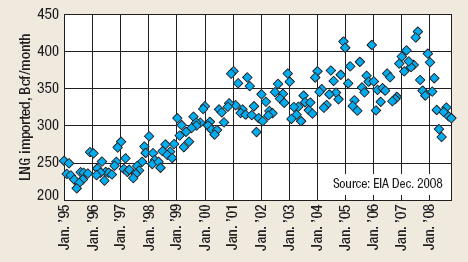 |
|
Fig. 2. US monthly gas imports, 1995 - 2008.
|
|
The US will likely remain the market of last resort for LNG, attracting spot cargoes only when prices in other markets are low. Total US gas consumption, which is more weather-driven than oil consumption, is expected by EIA to increase by 0.5% in 2008 and remain flat in 2009. If limited growth in gas demand persists, substantial increases in LNG demand should not be expected until around 2015.
This change in circumstances has two implications:
1. Expectations remain that the US will still require substantial LNG imports for the period beyond 2015. (EIA in December 2008 forecasts peak demand of 1.51 Tcf for LNG imports in 2018 compared with 0.73 Tcf in 2007.) If much of the LNG supply developed over the next decade is contracted by Asian and European consumers on a long-term basis, it may be difficult and expensive for the US to secure substantial LNG volumes in the future.
2. In 2008, new US LNG regasification terminals were brought onstream, and more are due for commissioning in 2009. Much of the existing capacity now seems set to remain idle or operate at very low load factors. The consequence of this is a likely postponement of many planned terminals, which will leave the West Coast markets particularly vulnerable when North American gas supplies become tighter.
EIA in December 2008 expected US LNG imports for that year to total just some 0.31 Tcf, and suggested only minor growth to some 0.37 Tcf in 2009. Such figures remain well below 2007’s 0.73 Tcf and suggest that LNG will remain marginal to US gas supply, demand and price for the next three to five years or longer, Fig. 4.
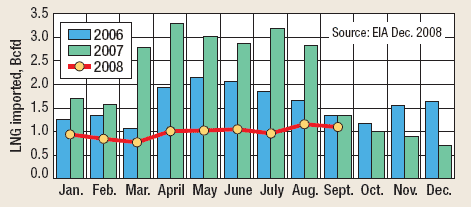 |
|
Fig. 3. Monthly LNG imports to the US, 2006 - 2008.
|
|
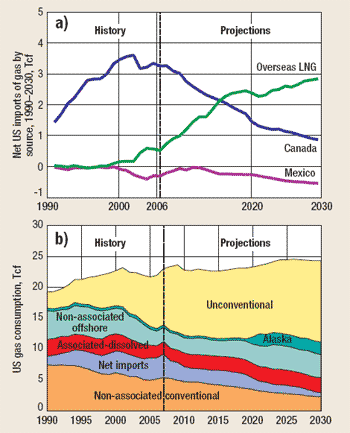 |
|
Fig. 4. a) The EIA Annual Energy Outlook in June 2008 forecast that US gas imports to 2030 would include a significant increase in LNG accompanied by a sharp decline from Canada. b) The EIA Annual Energy Outlook 2009 reference case (released in December 2008) removes that LNG increase, due primarily to Lower-48 onshore unconventional gas developments in 2007 and 2008.
|
|
During 2008, three new LNG receiving terminals were commissioned: offshore Boston (0.8 Bcfd, Excelerate Energy); Freeport, Texas (1.5 Bcfd, Cheniere); and Sabine, La. (2.6 Bcfd, Cheniere). New LNG terminals under construction in North America are Cameron LNG at Hackberry, Texas (1.8 Bcfd, Sempra); Golden Pass at Sabine, La. (2.0 Bcfd, ExxonMobil); Gulf LNG at Pascagoula, Miss. (1.5 Bcfd); Neptune LNG offshore Boston (0.4 Bcfd, Tractebel); and Canaport at St. John, N.B., Canada (1.0 Bcfd, Irving Oil). Expansions of the existing terminals at Cove Point, Elba Island and Sabine are also in construction. Not surprisingly, delays are being announced to some of these projects (e.g., Golden Pass due to Hurricane Ike storm damage).
Total existing US regasification capacity as of October 2008 is 10.735 Bcfd with an additional 8.8 Bcfd under construction, according to the Federal Energy Regulatory Commission. This expected 19.535 Bcfd of US regasification capacity by 2010 stands in stark contrast to EIA forecasts for US LNG imports of 0.47 Bcfd that year and 1.38 Bcfd in 2020.
In Mexico, the first LNG shipment arrived at Sempra’s Costa Azul terminal in Baja California in April 2008. That commissioning cargo came from Qatar, but Shell and BP, with capacity holdings in that terminal, have long been planning to deliver cargoes in 2009 from their newly commissioned liquefaction plants in Sakhalin and Tangguh. Costa Azul has strategic importance as the first operational LNG receiving terminal on the west coast of North America.
SOUTH AMERICA
The most significant LNG developments in South America during 2008 were the commissioning of small regasification terminals in Argentina and Brazil, both using floating Storage and Regasification Vessels (SRVs). In July 2008, the Bahia Blanca GasPort, Excelerate Energy’s fourth operational LNG facility and second dockside GasPort terminal, was commissioned to enable delivery of up to 400 MMcfd of gas to Argentina’s market (up to three cargoes per month). Bahia Blanca is located about 400 mi south of Buenos Aires and is likely to be the site of a baseload regasification terminal for which technical bids are under consideration by Enarsa, the state oil company. In June 2008, Excelerate became 50% owned by Germany’s RWE, one of several operators keen to pursue niche shipboard regasification opportunities.
In August 2008, Petrobras commissioned the Pecem terminal in Ceara State, in northeast Brazil, with a capacity of 250 Mcfd to deliver to local power plants. Petrobras plans to lease two SRVs for this operation from Golar Norway and has as many as five more such terminals planned, with LNG to be supplied mainly from Nigeria.
AFRICA
The long-delayed Angola LNG project finally received a go-ahead by Chevron and partners in 2008, with Bechtel commencing construction of the 5.2-MMty facility for commissioning in 2012. The plant will use ConocoPhillips’ optimized cascade process with a two-trains-in-one design. The project involves substantial offshore gas gathering facilities, as much of the plant’s supply is associated gas from deepwater oil fields. Elsewhere in West Africa, Equatorial Guinea is planning a gas hub to gather offshore gas from the Gulf of Guinea to expand upon the EG LNG Train 1 commissioned in 2007. New LNG projects in Nigeria were stalled in 2008 by escalating violence in the Delta and by the government’s insistence that gas for domestic power projects precede more LNG export projects. A significant development has been the commitment by Flex LNG, in a joint venture with Mitsubishi and Peak Petroleum, to construct a floating liquefaction vessel for deployment offshore Nigeria (OML 122). The plant will have capacity to produce 1.5 MMty of LNG for 15 years starting in late 2011. Meanwhile GDFSuez has commenced a feasibility study for a gas liquefaction plant in neighboring Cameroon.
In North Africa, liquefaction construction contracts were awarded in Algeria. KBR and Air Products are constructing the new 4.5-MMty train at state-owned Sonatrach’s Skikda to replace three trains destroyed in a 2004 accidental explosion.
In mid-2008, Sonatrach contracted Italy’s Snamprogetti and Japan’s Chiyoda to build a $4.55 billion, 4.7-MMty LNG train at Arzew due for completion in 2012, at which time Algeria’s total LNG production is expected to rise to 30 MMty. Gas feedstock for the new train at Arzew will come from the Gassi Touil and Rhourde Enouss gas fields.
Liquefaction plant developments are moving slowly in Libya. Shell is modernizing and extending the life of the old Marsa Al Brega facility (0.7 MMty) with additional phases to expand its capacity to 3.2 MMty and eventually to build a new plant, still in planning, adjacent to it. Eni and BP are still negotiating potential liquefaction projects in Libya, but with little apparent progress. Gas pipeline projects from North Africa to Europe are receiving more attention than LNG from the European utility buyers, with a view to securing large volumes of non-Russian gas without having to compete with other LNG consuming regions.
EUROPE
Probably the most significant event in 2008 for Europe’s LNG industry was the delivery of the offshore Adriatic LNG terminal, owned by ExxonMobil and Qatar Petroleum. It is a concrete, gravity-based structure (617 ft long, 289 ft wide and 154 ft tall) containing humid sand ballasting material placed on the seabed some 9 mi off Italy’s east coast in 95 ft of water. The terminal, constructed in Algeciras, Spain, consists of two storage tanks with a combined capacity of some 0.775 Bcfd, which will be supplied mainly from Qatar when it reaches full operational capacity in 2009. It has taken more than 10 years for this project to be completed, and many other proposed regasification projects languish while awaiting approvals through Italy’s far-from-streamlined regulatory process. BG, for example, is now into its fifth year of regulatory delays with its proposed Brindisi terminal.
Approvals have proved easier to obtain in the Netherlands, and two projects have taken significant steps forward in 2008. Gate LNG in Rotterdam commenced construction and secured project finance for a 420-Bcfd terminal to be completed in 2011 with Gasunie and Vopak holding 80% equity and four customers (Dong, Essint, OMV and EON) each holding 5% equity. LionGas LNG, a competing 320-Bcfd facility operated by independent 4Gas, has received environmental permits and leased a site from the Port of Rotterdam with plans to be operational by 2012.
The arrival of the 7.63-MMcfd Q-Flex gas carrier Al Khuwair, with 4.8 Bcf of gas for Centrica to commission the Phase 2 expansion of the Grain LNG terminal, made an impression in November 2008 in UK. The third-phase Grain LNG expansion, in which Centrica also holds long-term capacity, is underway for a 2011 start. However, commissioning of the two LNG terminals nearing completion in Wales-South Hook and Dragon-is further delayed into 2009. Similarly the Fos-Cavaou terminal in southern France is now expected to be operational in June 2009, some two years after GDF and Total’s initially scheduled start date.
On the liquefaction side, Europe’s only liquefaction plant at Snohvit, Norway, has had a dismal initial year of production, with a number of significant and expensive technical process problems to overcome and extensive downtime. Its already high break-even price will be further challenged in 2009 by the collapse of US LNG demand.
VOLATILITY IN SHORT-TERM LNG TRADING
The current LNG market is not conducive to holding short-term cargoes, as the recent history of Distrigas’ Methania testifies. The Methania was loaded with LNG at Zeebrugge in October 2008 in the expectation that it would find a buyer willing to pay a higher price for the cargo previously imported at Belgium’s Zeebrugge terminal. It sat idle for several weeks off Falmouth, failing to find a buyer. Eventually, in early December, Methania delivered part of its cargo in Barcelona, Spain, and part to Sines, Portugal. As it costs tens of thousands of dollars per day to keep an LNG carrier at sea, that particular cargo was clearly not one of the most profitable delivered in recent months.
The outcome for that cargo contrasts markedly with that of another 2008 LNG cargo originally loaded in Qatar, shipped initially to Zeebrugge, whereupon it was reloaded and re-exported to Hazira in India. Indeed there were several instances of short-term cargoes sailing from North and West Africa to Asian markets earlier in 2008 and selling at prices above $20/MMBtu. The short-term LNG market is far from efficient in terms of ocean-miles and shipping costs, but when operators can easily double the unit prices they receive for cargoes when gas is short in any particular market, it is clear why there are participants willing to take the risks.
Taking into account current market conditions and the liquefaction capacity scheduled to come onstream in the next few years (Fig. 1), and the availability of plenty of shipping and regasification capacity, Fig. 5 suggests that the LNG market is likely to remain oversupplied until 2012. This, and the global recession and financial constraints, may lead to delays in commitments to build new liquefaction capacity, which are likely to then lead to a supply shortfall from about 2014.
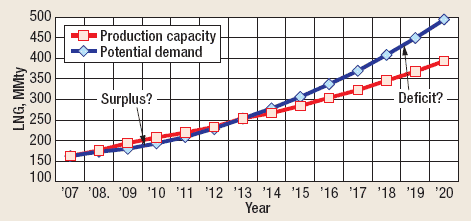 |
|
Fig. 5. Global LNG supply demand forecast to 2020.
|
|
IMPACT OF THE ‘GAS TROIKA’ AND GECF
The world’s largest proved gas reserve holders-Russia, Iran and Qatar (with some 60% by volume)-announced the formation of a technical committee, dubbed a “gas troika,” in October 2008 to pursue common strategic interests. In December 2008, ministers from the 14 members of the Gas Exporting Countries Forum (GECF) passed a formal charter and agreed on a plan to establish a permanent base in Doha, taking one step closer to an OPEC-style cartel for gas. GECF members are Algeria, Bolivia, Brunei, Egypt, Indonesia, Iran, Libya, Malaysia, Nigeria, Qatar, Russia, Trinidad and Tobago, the United Arab Emirates and Venezuela. Equatorial Guinea and Norway are GECF observers. It is not clear yet whether all 14 GECF members will move forward with its new politically overt focus and more OPEC-like structure, which includes a head office, annual fee and decision making that is binding on members. Minister statements suggest that Indonesia for one may not.
Most of the world’s major LNG producers are involved in the GECF, but it is hard to see how policies that might restrict future gas supply or a system of production quotas could evolve and be influenced by the gas strategies of Bolivia, Iran and Venezuela, countries with no prospects of becoming LNG exporters in the next five years. The main impact of an OPEC-style GECF in the medium term seems to be a further extension of Russia’s influence on global gas supply and its midstream infrastructure. This, together with Russian military activities in Georgia in 2008 and the current wrangling with Ukraine that has reduced European supplies, should actually boost the LNG industry by encouraging European consuming nations to further diversify their gas supplies. Australasian gas liquefaction projects and others outside the GECF sphere of influence, particularly those in Papua New Guinea and those sourced by CBM, may find it easier to secure investment as a consequence of a more vociferous and politically assertive GECF.
|
THE AUTHOR
|
|
|
David Wood is an international energy consultant specializing in the integration of technical, economic, risk and strategic information to aid portfolio evaluation and management decisions. He holds a PhD from Imperial College in London. Research and training concerning a wide range of energy-related topics, including project contracts, economics, gas/LNG/GTL, portfolio and risk analysis, are key parts of his work. He is based in Lincoln, UK, and operates worldwide. Please visit his website at www.dwasolutions.com or contact him by e-mail at woodda@compuserve.com.
|
|
|








